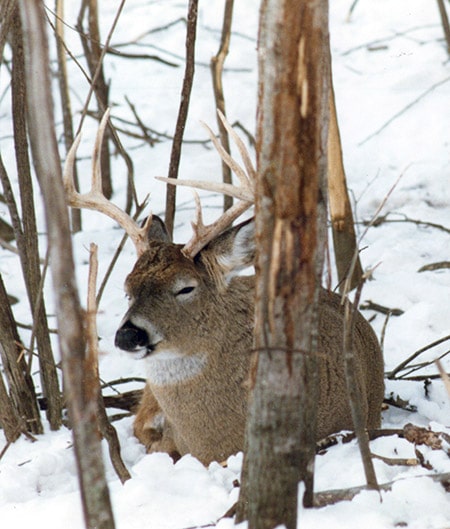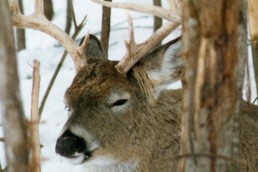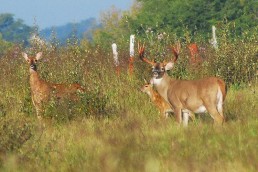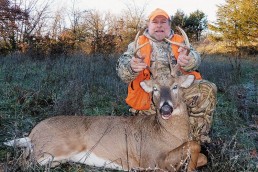Curse of the Red-antlered Buck
SHARE THIS POST
We knew bucks-only hunting would be tough this year. Six days of pre-season scouting by seven in our gang had turned up very few fresh buck signs. Tracks, droppings, beds and trail cams revealed three antlered bucks, one big, inhabited one of the 5 square miles we hunt. Two were lesser bucks, and expected to be run off by the dominant buck while breeding was in progress. Three of the other miles hunted were inhabited by one buck each; all big, dominant breeding bucks with 4-inch hoofprints and clumped droppings at 7/8 inch or longer. Like during the past three hunting seasons, 1 square-mile was again completely devoid of fresh deer signs of any kind.
It wasn’t unexpected. Very few fawns and yearlings had survived our two severe winters three to four years ago. Our past two mild winters had improved numbers of fawns born (twins common) during each of our past two springs, but our gray wolves had taken their usual toll of three of four fawns by early November. Surprisingly, however, several mature does had migrated into our hunting area last spring, adopting doe home ranges that had been empty for two to three years. Right now we have an unprecedented number of surviving fawns—nine of them in 5 square miles. Hopefully, another mild-to-moderate winter will give them a chance to grow older. Even so, only half can be expected to be bucks and it will take two or more years for them to become desirable quarries.
All this meant is that my 11 hunting partners and I only had four bucks to hunt in our “bucks-only” hunting area this year. Being survivors of five to six years of hunting by wolves and humans, these bucks would be no pushovers.

As I predicted months go, we began our Minnesota firearm-hunting season without snow. Moreover, as has become almost customary during the past two decades, it was warm and mild with the prevailing wind blowing from the south. By day three, we were in the dark of the moon, meaning we could expect to see our wolf country whitetails feeding as late as 10 a.m. for at least a week once normal temperatures resumed.
The trouble was from Saturday through Wednesday the temperature was near or in the 40s at sunrise, and it rose into the mid-50s and low 60s by midday. Having fully developed winter coats, our whitetails didn’t like the heat. Throughout those first five days of the hunting season, most of them spent their daylight hours lying in shade and then limiting activities—including breeding—to cooler nighttime hours only. Accordingly, our hunting season again began as one of the quietest in memory (gunshots rare).
Some years ago I fell asleep behind a makeshift blind (upturned roots of a fallen spruce) about 25 feet downwind of a freshly renewed buck ground scrape. When I suddenly awoke, I found myself staring into the eyes of an enormous buck with dark, reddish-brown antlers standing 30 feet away on my right. Following one blink of my eyes, it leaped high into the air, landed on its ground scrape, made a twisting turn to its right and disappeared from sight about 8 feet above the ground, as it soared through inter-lapping boughs of a line of black spruce trees, snorting repeatedly as it fled. That buck taunted me twice more that season, once while I was unknowingly walking past it in dense cover, snorting once to let me know it was near and then disappearing after giving me another quick glimpse of its huge reddish antlers; it did it again a few days later after creeping up behind me from downwind while I was keeping an eye on one of its favorite feeding areas.
What has this got to do with our past hunting season? Be patient.
While scouting last October, my son, John, and I decided to check out a stand site we named the “Lonesome Pine Stand.“ It was located near a huge pine near the north side of a vast clear-cut that had been devoid of all deer signs ever since the second of our recent devastating winters. This stand is a natural ground-level blind formed by a huge, fallen pine about 15 yards from the edge of the clear-cut. Out in the clear-cut, 50 to 70 yards from the stand site, John and I discovered numerous puddles of droppings of a size characteristic of a mature doe (1/2 inch long), most old and dry, some fresh and shiny, revealing at least one mature doe had often fed on grasses here. Scattered throughout the clear-cut were numerous clumps of second-growth aspens and woody shrubs, including red-bark dogwoods, sugar maple saplings (also red) and hazels 4 to 6 feet tall. The red shrubs are favorite browse plants of our northern whitetails after the first week in November. Though we consider feeding areas currently favored by does to be prime stand sites for taking bucks while breeding is in progress in November, a lack of buck-sized tracks and droppings in the clear-cut and its vicinity didn’t put this site high on our list of spots to hunt.
“That middle stand on the back side of the Moose Mountain clear-cut looked awfully good to me,” John mentioned, as we drove home. “A big buck has obviously been spending a lot of time there. If the wind is right, that’s where I plan to hunt opening morning. The spot where I use to hunt with my climber off of Slippery Rock Trail looks good to me for the same reason (we name everything to make it easier to discus and understand hunting plans). I’ll need a north or northwest wind to hunt that site, however, a wind direction we don’t often get on the opener.”
“Mostly sunny with a high of 54 and a southwest wind gusting to 15 mph,” the announcer said, on our weather radio at 4 a.m. opening morning.
“Great for Jimmy (John’s son) and me,” John said. “I guess we’ll be making that tough, 2-mile hike around Moose Mountain this morning. Where are you going to hunt, Dad?” John asked.
“It’s not the greatest stand site, but the wind is right,” I grumbled, “so I think I’ll give Lonely Pine a try.”
At 6 a.m. I turned right from a moss- and spruce-covered ridge on the way to my stand and began a careful descent toward the clear-cut, angling through dark evergreens toward the big fallen pine. Minutes later I was ready—I was seated on my backpacked stool, camo head net pulled down over my face (camo-blaze-orange cap on top) and peeking between two long-dead horizontal branches atop the fallen tree trunk toward the dark and silent clear-cut.
Throughout the following three hours, the only things that moved within sight were a raven and a red squirrel with cheeks stuffed with pine nuts. Several times during its rapid dashes across the top of my hiding place it halted to briefly stare at me. Unlike countless of its brethren I have known, this squirrel was not given to panic or ire, not giving my presence away via furious, hiccup-like barking. Curious to discover where it was storing its winter supply of food, I raised my head to watch its movements, as it leaped from my blind and dashed away on my right.
Are you enjoying this post?
You can be among the first to get the latest info on where to go, what to use and how to use it!
Then, I almost choked with surprise.
Walking toward me less than 50 yards away was an enormous buck with a greatly enlarged neck, the largest and brightest throat patch I have ever seen, almost square in shape, wide and tall and dark with shiny antlers.
Immediately upon ducking down, hoping I hadn’t been seen, I began the double-thumb squeeze needed to silently ease off my rifle’s safety (a Ruger Model 70). I then eased my rifle barrel toward the treeless gap in front of my blind and waited.
Meanwhile, it occurred to me this buck’s antlers appeared to be a familiar dark reddish-brown. Am I imagining things? I wondered, “Or is this buck a descendent of the red-antlered buck I met about 400 yards from this site many years ago?
Where is it? I soon began to wonder. It should have reached this gap by now. Oh no.
I then silently moaned, “It’s standing broadside behind that mass of hazels (70 yards away), ears cocked forward and eyes staring directly at me.”
Obviously, it didn’t know what I was, acting more curious than alarmed (tail down). It was the biggest, most beautiful buck I had ever seen in 71 years of whitetail hunting, easily weighing more than the usual 305 pounds typical of dominant breeding bucks in our hunting area. As I stared back, not daring to move, I noted wide bands of white ringing its nose and eyes. Its thick antlers, dark reddish-brown for sure, spread far past the sides of its head. Its inside spread had to be nearly 30 inches, and some of its tines had to be 16 inches tall. After seeing so many 10-pointers in my years of hunting, it was obvious this buck was a 12-pointer or better.
A very slow scan revealed the buck’s entire torso was well screened by those intervening hazels. There was no chance one of my fast-moving 150 grain 7 mm Magnum bullets could penetrate that mess. The buck’s head and upper neck were clearly visible, however, or so they seemed. I have dropped quite a few bucks upon firing at their throat patches, and this buck’s huge throat patch was certainly an inviting target, being unusually large and bright. I therefore centered the crosshairs of my scope on the center of this target with the forearm of my rifle, resting across the lower horizontal branch at the top of my blind and fired.
… Nothing happened.
The buck didn’t move, at least not until I ejected my spent shell and jacked in a fresh cartridge. Upon hearing this, it immediately began bounding away toward the east, its rapid progress revealed by mere quick glimpses between intervening brush and trees. During the last glimpse, I noticed the buck’s tail was horizontal, not fully upright or fanned.
No hair or blood dotted the ground where the buck had been standing. A freshly clipped branch in the hazels revealed why. As has occasionally happened during my many years of whitetail hunting, my 7 mm Magnum bullet had fragmented or ricocheted upon hitting that unnoticed, intervening branch. Upon plowing through the trunk of a slender ash, five parts of my fragmented bullet had hit the largest buck I have ever taken, many years ago. It took three miles of tracking to finally catch up with that buck. Wondering if I now faced a similar situation, I began making ever-widening circles about the spot where the buck had stood, searching for blood signs. Two hours later, I finally gave up. Incredibly, the red-antlered buck had not been touched.
It makes me wonder: Are red antlers a source of protective magic among white-tailed bucks? At my age, I guess I’ll never know, but one thing is sure certain—big bucks tend to be very lucky.
Dr. Ken Nordberg has written more than 700 magazine articles and 12 books on the habits and hunting of whitetails and black bears, including the “Whitetail Hunters Almanac” series. He also produced “Doc’s Buck and Bear Hunting School” videos. His encyclopedic website is at drnordbergondeerhunting.com.
MWO
SHARE THIS POST
Did you enjoy this post?
You can be among the first to get the latest info on where to go, what to use and how to use it!
Dr. Ken Nordberg
Based on his 55 years of field research, Dr. Ken Nordberg has written more than 800 magazine articles, 12 books on whitetails—including the famous Whitetail Hunter’s Almanac series—five books on black bear hunting and produced Buck and Bear Hunting School videos. You may peruse his encyclopedic website with whitetail hunting tips: drnordbergondeerhunting.com, his blog: drnordbergondeerhunting.wordpress.com, or social media pages.



